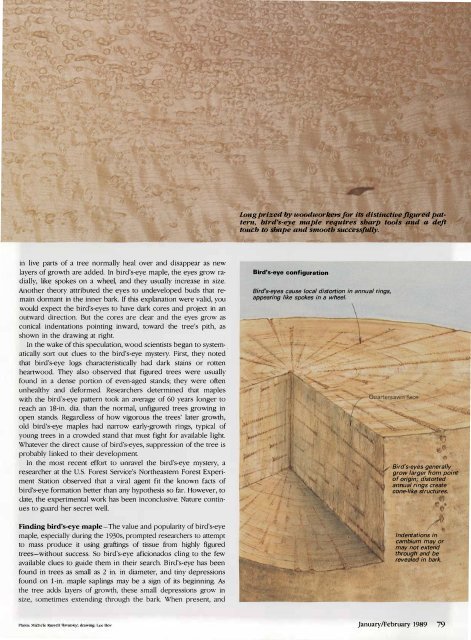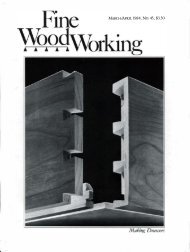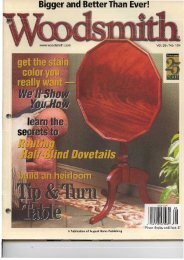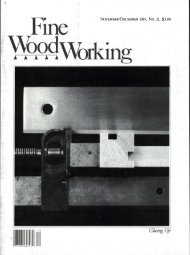.Bird's-Eye MapletUTe JItIlunts her 'Midas touch'Collecting and stockpiling interesting woods for pet projectsis characteristic of woodworkers, and I'm no exception. Ihave a particular soft spot for bird's-eye maple. Once a lumberdealer steers me to d1e yard's maple staSh, I quickly find myselfout of control and reaching for my checkbook. But what is themystique about bird's-eye maple mat turns woodworkers intowood worshippers ? It may be its golden-grain beauty and rarity, orit may be mat nobody can explain how the eyes form. Like a jewelscattering light, mis unique wood provides few clues to me mysteriousprocess that forged it.The distinctive figure, named for the way each tiny swirl resemblesme eye of a bird, is usually found in me sugar or hard mapleCAcer saccharum), one of Norm America's most distinctive trees,known for its shade, cream-color lumber and sticky harvest of sap.The bird's-eye figure can be found wherever maples grow, but it'smost common in me harsh growing conditions of me north country.Occasionally it's found in omer wood species, including soft maple,yellow birch, ash and ponderosa pine. Whatever the cause ofd1e figure, it's a result that woodworkers prize. When a bird's-eyelog is split along a plane tangent to the growd1 rings, the woodseparates, exposing a bulging cone that extends inward on mebark-facing side of the wood and a matching pit on me log's omerside. When a log is sliced lengthwise or rotary-cut for veneer, theresult is me familiar bird's-eye pattern.Individual eyes can be as tiny as pinpricks or me size of a quarter.Once bird's-eyes begin to appear, they propagate, becoming largermrough succeeding outer layers of growth. Often me bird's-eyescontinue to form throughout me life of me tree. Or, they may endabruptly several inches beneath the surface of me log-happy surprisesthat lie in wait for woodworkers.Bird's-eye and other maples have figured prominently in Americanwoodworking and furniture history. I'll tell you a little about itbefore discussing what we know about bird's-eye formation andd1e practical aspects of how to work wim it.Bird's-eye history-American furnituremakers have used bird'seyeveneer for more than two centuries. Almough little has beenrecorded about its use, early furnituremakers often used maple inintricate inlays. In me late 1700s, for example, bird's-eye flourisheswere common on furniture of the Federal period.By the late 19m century, detailed handwork combined wim lavishbird's-eye touches had found its way into art-nouveau furnitureand d1e resurgent Louis XV movement. In the late 1920s, a time oftransition marked by the merging of a new linear functionalismwith ornate traditionalism, me bird's-eye pattern found its niche asa stylistic ornamentation playing counterpoint to the crisp geometryassociated wim design trends such as Art Deco.Virginia Boyd, a University of Wisconsin-Madison historian whospecializes in American interiors, says bird's-eye maple was alsoused at this time for reproduction work-Chippendale and omercolonial-revival pieces. Though seldom used in the originals,bird's-eye, to me 20th-century mind, became associated wim thenostalgic. "It was a hearkening back to an older time and style,even hough it wasn't an accurate look back," Boyd said.Today, bird's-eye maple has found favor as a highly prized speialtywood in the repertoire of many woodworkers. While Europeans,especially Germans and Italians, seem to favor bird's-eye veneer,American woodworkers employ both veneer and solid wood. It'snot unuual in the United States to find furniture made entirely ofsolid bird's-eye maple.Origins-As long as bird's-eye maple has been around, so havequestions about its origin. Why does bird's-eye occur almost exclusivelyin maple ? Why does it appear in such varied patternsmroughout a given tree ? Like random splotches from a frenziedpainter'S brush, bird's-eyes may appear over me entire lengd1 of atree, be confined to one side or scattered in irregular patches.Why, no one knows.Theories about what causes me swirling figure have been as variedas me patterns of the figure itself. Early investigators thought itwas caused by a parasitic fungus dut attacked me cambium, memin layer between bark and wood dut produces new wood cells.Omers suggested it was caused by boring insects, or that woundsinflicted by birds during the tree's early growd1 resulted in pits orgrooves, which over time were fi lled in wim fresh layers of woodgrowm. But these explanations don't make sense, because wounds78 Fine Woodworking
Long prized by woodworkers for its distlnctl figured pattern,bird's-eye maple reqwf;xes sharp tools and (#. defttouch t() shape and smooth successfulh'.in live parts of a tree normally heal over and disappear as newlayers of growth are added. In bird's-eye maple, the eyes grow radially,like spokes on a wheel, and they usually increase in size.Another theory attributed the eyes to undeveloped buds that remaindormant in the inner bark. If this explanation were valid, youwould expect the bird's-eyes to have dark cores and project in anoutward direction. But the cores are clear and the eyes grow asconical indentations pOinting inward, toward the tree's pith, asshown in the drawing at right.In the wake of this speculation, wood scientists began to system- .atically sort out clues to the bird's-eye mystery. First, they notedthat bird's-eye logs characteristically had dark stains or rottenheartwood. They also observed that figured trees were usuallyfound in a dense portion of even-aged stands; they were oftenunhealthy and deformed. Researchers determined that mapleswith the bird's-eye pattern took an average of 60 years longer toreach an IS-in. dia. d1an the normal, unfigured trees growing inopen stands. Regardless of how vigorous d1e trees' later growti1,old bird's-eye maples had narrow early-growth rings, typical ofyoung trees in a crowded stand that must fight fo r available light.Whatever the direct cause of bird's-eyes, suppression of the tree isprobably linked to their development.In the most recent effort to unravel the bird's-eye mystery, aresearcher at d1e U.S. Forest Service's Northeastern Forest ExperimentStation observed that a viral agent fit d1e known facts ofbird's-eye formation better than any hypothesis so far. However, todate, the experimental work has been inconclusive: Nature continuesto guard her secret well.Finding bird's-eye maple -The value and popularity of bird's-eyemaple, especially during the 1930s, prompted researchers to attemptto mass produce it using graftings of tissue from highly figuredtrees-without success. So bird's-eye aficionados cling to d1e fewavailable clues to guide them in their search. Bird's-eye has beenfound in trees as small as 2 in. in diameter, and tiny depressionsfound on I-in. maple saplings may be a sign of its beginning. Asthe tree adds layers of growth, these small depressions grow insize,ometimes extending through the bark. When present, andBird's-eye configurationBif:eJ's-e'fJ-es cause local distelifien in annual flings,aPleafting like spokes in a wheel.Bird's-eyes generallygrow larger from pointof erigin; distortedali/li/ual "ings createcOli/e-like structures.fJ?:Indentations incambium may ormay not extendtht'eugh and belie.v,ealed in bark.I>holo: Michele RussellI;winsk)': drawing: I.ee Ho\'January/February 1989 79
- Page 3 and 4:
FineW> rktng'_' ______ ___ January/
- Page 6 and 7:
Letters (contillued)never hurt hims
- Page 8 and 9:
MetiJods of Wo rkedited and drawn b
- Page 10 and 11:
Methods of Wo rk (contillued)exampl
- Page 12 and 13:
Making a door sandwichI intend to m
- Page 14 and 15:
Q & A (colltillued)of a bad situati
- Page 16 and 17:
Pollou'-upby Dick BurrowsMore on to
- Page 18 and 19:
Easy toStep by Step DrawingsBuildOn
- Page 20 and 21:
(25 years)P-SOO20" PlANERSEATTLE:1
- Page 22 and 23:
There areover 4,000money-savingreas
- Page 24 and 25:
READY TO ASSEMBLE-SOLID-CHERRYWALNU
- Page 26 and 27:
THE BARTLEYBUNDLES!AlJ.500 ·24"Ban
- Page 28 and 29: A GREAT DEA.L IMORE (f)5 HP, 3 Ph3
- Page 30 and 31: --ANTIQUE & USED TOOLSQuality, olde
- Page 32 and 33: PhoneStater--- - -[][]Ur:iTheWoodwo
- Page 34 and 35: """""',' Universal Precision Measu
- Page 36 and 37: FineWorking January/February 1989M
- Page 38 and 39: Once the backrest plaques are joine
- Page 41 and 42: Fig. 4:.1:iim.lf1lmllli.iiiiie?tII
- Page 43 and 44: Secret compartments were so common
- Page 45 and 46: -----.JFig. 4: Hanging tray below t
- Page 47 and 48: Tbree examples of the author's slid
- Page 49 and 50: worked but will maintain a crisp, s
- Page 53 and 54: SCROLL-SA W TESTCompany and model L
- Page 55 and 56: An ordinary woodturning lathe can b
- Page 57 and 58: use a dust collector, and if possib
- Page 59 and 60: I've never been especially fond of
- Page 61 and 62: and it shields your fingers from ex
- Page 63 and 64: The cabinet scraper used by the aut
- Page 65 and 66: Fig. 2: Post:Modern Table Top, 52 i
- Page 67 and 68: Fig. 3: LFI TableNut is fastened to
- Page 69 and 70: Fig. 3: Curved miterPattern doesn't
- Page 71 and 72: Selections from the author's sketch
- Page 73 and 74: thor anticipate problems and make f
- Page 75 and 76: Fig. 2: Air flowMoist air exits thr
- Page 77: lating fan. The idea here is to ins
- Page 81 and 82: A Chinese woodworker assembles an e
- Page 83 and 84: Chinese shaping toolsThroughout Chi
- Page 85 and 86: Using a Holtzapffel ornamental lath
- Page 87 and 88: NOW! BUY BRIDGEWOOD IN CANADA . ..
- Page 89: QiUl j!! IIIc:Ul.=:c ...!!
- Page 92 and 93: 111,"11SIOPm'EI.I,lu it ....IS •
- Page 94 and 95: CARBIDE TIPPED ROUTER BITSPRCAL PRO
- Page 96: FS Tool CorporationP.o. Box 510, 21
- Page 99 and 100: ... !Ij*;::""' eMore NTS 14-5614" H
- Page 101 and 102: FI:\ISHI:\G SLPPLIESIf you have bee
- Page 103 and 104: T\UNTONPUBliCATIONS... by fellow en
- Page 105 and 106: PmeWqqQWorkingIndex to issues 66 th
- Page 107 and 108: FowlerFowler, Brian, chair by, 67,1
- Page 109 and 110: ScrewsZimmerScrews:brace driving of
- Page 111 and 112: 34-76 1 10' Uni s-l-l/2 hp ........
- Page 113 and 114: MOISTURE METERFAMOUS "MINI-LiGNO"MA
- Page 115 and 116: Dependable extra hands for all type
- Page 117 and 118: MIRRORA· THE HAND MIRRORCOMPLEMENT
- Page 119 and 120: £'Delrl.lnc'e To Manufacture Quali
















